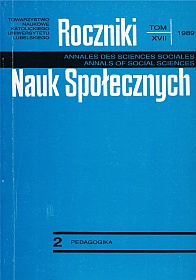Dwie propozycje badania małych grup
Abstrakt
Zwei Vorschläge zur Untersuchung kleiner Gruppen
Der vorliegende Text enthält die Besprechung zweier sich wechselseitig ergänzender Vorschläge zur Untersuchung kleiner Gruppen. Beide verstehen die Gruppe als Organismus, der lebt und wirkt, der seine Biographie besitzt, mit der gesellschaftlichen Umgebung verbunden ist, deren Anforderungen verwirklicht und zugleich die individuellen Bedürfnisse der Teilnehmer befriedigt.
Jede kleine Gruppe setzt sich zusammen aus gewissen Bereichen, die zugleich die Quelle der in der Gruppe wirkenden Kräfte sind. Von ihrer Aktivität hängt die Art und die Qualität der Verwirklichung der Bedürfnisse der Gruppenmitglieder sowie die Erfüllung der Gruppenaufgaben ab. Eine allzu grosse Kräftekonzentration in einer gegebenen Region ist ähnlich wie die Ausbreitung auf andere Bereiche eine Quelle von Spannungen, der Destabilisierung des Lebens und Wirkens der Gruppe und manchmal geradezu ihres Zerfalls.
Dieselben kleinen Gruppen können als Gesamteinheiten verstanden werden, die sich aus drei Systemen zusammensetzen, die drei Grundaufgaben verwirklichen. Diese Systeme sind: die Persönlichkeit, das soziale System und das kulturelle System. Jedes davon verwirklicht auf seine Weise drei Aufgaben es stärkt die Identität der Person und der Gruppe, es entwickelt Weisen der Beziehung auf eine weitere Gemeinschaft, und es gestaltet Weisen der Anpassung an die Realität. Die Gruppe kann in fünf Perspektiven gesehen werden: hinsichtlich Struktur, Entwicklung, Adaptation, Transaktion und Gestalt.
Ein vollständiges Bild der Gruppe kann erst dann schaffen, wenn man sie von allen fünf Gesichtspunkten her erfasst. Sie bilden den theoretischen und praktischen Rahmen, in dem die Untersuchungen und die Arbeit in der Gruppe durchgeführt werden können.
Bibliografia
Anderson R., Carter I.: Human Relations in the Social Environment, Chicago 1974.
Ashby R.: Design for a Brain, New York 1960.
Bales R. F.: Interaction Process Analysis: A Method for the Study of Small Groups, Reading, MA: Addison-Wesley 1950.
Bales R.F., Strodtbeck F.L.: Phases in Group Problem Solving, "Journal of Abnormal Social Psychology", 1951, 46, s.485-493.
Benne K., Sheats P.: Functional Roles of Group Members, "Journal of Social Issues" 1948, 4, s.41-49.
Bennis W., Shepard H.A.: A Theory of Group Development, "Human Relations" 1956, 9, s.415-437.
Berrien K.: General and Social Systems, New Brunswick N.J. 1968.
Bertrand A.: Social Organization: A General Systems and Role Theory Perspective, Philadelphia 1972.
Bion W.R.: Experiences in Groups, New York 1961.
Boyd R.D., Wilson J.P.: A Three Channels Model for Analysis of Communication, Office of Education, National Center for Educational Research and Development, Washington D.C.
Boyd R.D., Apps J.W.: Redefining the Discipline of Adult Education, San Francisco 1980.
Carkhuff R.: Helping and Human Relations, Vol. II, New York 1969.
Cartwrihgt D., Zander A.: Group Dynamics: Research and Theory, Evanston, IL, 1960.
Cohen A., Smith R.D.: The Critical Incident in Growth Groups: Theory and Technique, La Jolla 1976.
Garland J.A., Jones H.E., Kolodny R.L.: A Model for Stages of Development in Social Work Groups, ed. S.Bernstein, w: Explorations in Groups Work, Boston 1965.
Hare P.A.: Theories of Group Development and Categories for Interaction Analysis, "Small Group Behavior", 1973, 4, s.259-304.
Heider F.: The Psychology of Interpersonal Relations, New York 1958.
Hill W.F.: Hill Interaction Matrix, Los Angeles 1965.
Hill W.F., Gurner L.: A Study of Development in Open and Closed Systems, "Small Group Behavior", 1973, 4, s.355-381.
Homans G.C.: Social Behavior. Its Elementary Forms, New York 1961.
Lieberman M., Yalom I., Miles M.: Encounter Groups: First Facts, New York 1973.
Newcomb T.M.: The Acquaintance Process, New York 1961.
Rogers C.R.: On Encounter Groups, New York 1970.
Sarri R.C., Galinsky M.T.: A Conceptual Framework for Group Development, ed. R.D.Vinter, w: Readings in Group Work Practice, Ann Arbor 1967.
Schutz W.C.:Joy: Expanding Human Awareness, New York 1969.
Schutz W.C.:FIRO: A Three-Dimensional Theory of Interpersonal Behaviors, New York 1958.
Slater P.E.: Microcosm: Structural, Psychological and Religious Evolution in Groups, New York 1966.
Stock D., Thelen H.A.: Emotional Dynamics and Group Culture: Experimental Studies of Individual and Group Behavior, New York 1958.
Stogdill R.M.: Individual Behavior and Group Achievement, a Theory: The Experimental Evidence, New York 1959.
Thelen H.A.: Work-emotionality Theory of the Small Group as Organism, ed. S.Kock, w: Psychology: A Study of a Science, Vol.3, New York 1959.
Thelen H.A., Stock D.:Methods for Studying Work and Emotionality in Group Operations, Chicago 1954.
Tuckman B.W.: Development Sequence in Small Groups, "Psych. Bull.",1965, 62, s.384-399.
Yalom I.: The Theory and Practice of Group Psychotherapy, New York 1975.
Copyright (c) 1989 Roczniki Nauk Społecznych

Utwór dostępny jest na licencji Creative Commons Uznanie autorstwa – Użycie niekomercyjne – Bez utworów zależnych 4.0 Międzynarodowe.


